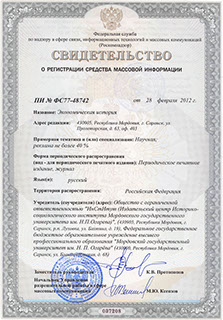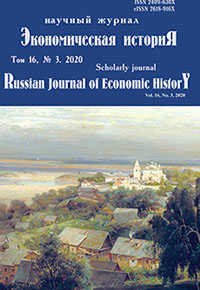Экономическая историЯ
Russian Journal of Economic History
ISSN 2409-630X (Print)
ISSN 2618-916X (Online)
Expert board:
- Scientific Council of RAS on economic history;
- Research and Educational Center «The economic history of Central Russia and the Middle Volga region» of Ogarev Mordovia State University;
- Center of Economic History of Lomonosov Moscow State University
Navigation
Certificate of registration

ISSN 2409-630X (Print), ISSN 2618-916X (Online)
DOI: 10.15507/2409-630X.050.016.202003.241-268
УДК 332.055.2
Dmitry Yu. Karasev
Russian Presidential Academy of National Ecomony and Public Administration (Moscow, Russia),
e-mail: dk89@mail.ru
Measuring Nineteenth Century Regional Economic Growth: Historiography and Methods
Introduction. The scope of regional economic inequality, its causes and consequences are relevant issues in the economic history. High regional inequality impedes representative estimation of national economic development and international comparison. The end of 19th and beginning of 20th centuries was the time when industrialization, states’ economic and political integration led to their regional divergence/convergence. Methods. The main challenge of measuring and accounting for 19th century regional economic growth is a scarcity of regional historical and economic statistics. Thus, the paper concerns with historiographical analysis of successful attempts to face this challenge in economic history. Results. It can be distinguished three approaches to historical regional economies accounting depending of relevant statistics availability: 1) for countries with high regional-data integrity, GRP can be estimated as a sum of its residents’ incomes (R. Easterling’s method); 2) for countries with moderate regional statistics being saved, it is possible to estimate GRP through distributing known GDP totals across regions on the basis of indicators of regional sectors’ shares (Geary-Stark method); 3) for countries with poor regional historical statistics it fits only short-cut approach on the basis of indirect regional economic indicators (Crafts’ approach and Good–Ma method). Furthermore, the paper deals with following methods and models used in quantitative explorations of unequal regional economic development: shift-share analysis, β and σ-convergence. Discussion. It appears that historical statistics from the Governors reports makes possible to distribute known national values added in the first and secondary sectors across provinces of the late-nineteenth century Russian Empire in the line with Geary–Stark methodology. The contribution of tertiary sector to the provinces’ economic growth could be estimated on the basis of indirect indicators from the same historical source and the other sources, following Good–Ma methodology. Finally, the cross-checking of the GRP to be calculated is possible through comparison with A. Markevich estimates for 1897.
Keywords: historiography and methods, economic growth indicators of 19th century regions, GRP, Geary–Stark method, shift-share analysis, β and σ-convergence, the late-nineteenth century Russian Empire provinces.
For citation : Karasev D. Yu. Measuring nineteenth century regional economic growth: historiography and methods. Ekonomicheskaya istoriya = Russian Journal of Economic History. 2020; 16(3): 241–268. (In Russ.).
DOI: 10.15507/2409-630X.050.016.202003.241-268
© Ogarev Mordovia State University. History and Sociology Institute, 2017
68, Of. 411, Bolshevistskaya St., 430005, The editorial office of the scholarly journal «Russian Journal of Economic History»
Tel.: (8342) 24-25-90; 27-07-11, Fax: (8342) 24-25-90, E-mail: jurnal-econom-hist@isi.mrsu.ru
Designed by A. Napalkov, Email: napalkov@isi.mrsu.ru

